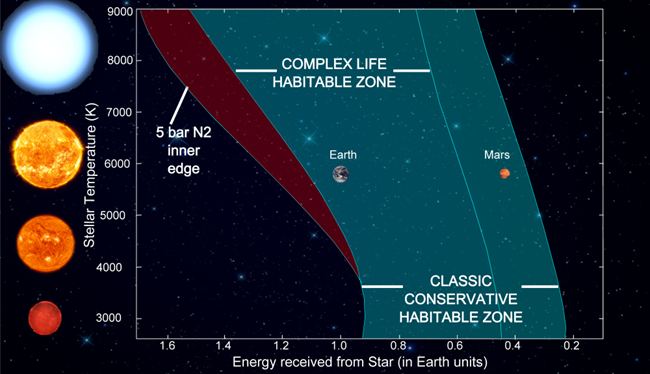
Abstract:
To find potentially habitable exoplanets, space missions employ the habitable zone (HZ), which is the region around a star (or multiple stars) where standing bodies of water could exist on the surface of a rocky planet. The key atmospheric gases in the classical HZ definition are CO2, H2O, and N2. Although climate models traditionally assume an Earth-like 1 bar N2 background atmosphere, little work has been done to assess how HZ boundaries change at elevated background N2 levels. First, I show that the solar system HZ inner edge moves closer to the Sun by ~0.1 AU, assuming a 5-bar N2 atmosphere. Wider HZs (~20% wider) are also found for A- M stars. I also show that the runaway greenhouse threshold temperature decreases with increasing N2 pressure. Unlike what had been calculated previously, moist greenhouses are not triggered for planets orbiting F – M stars. However, these earlier studies finding moist greenhouses also obtain nearly global surface temperature inversions. Here, I argue that such inversions do not satisfy surface energy balance and are probably nonphysical.
Lastly, previous work had correctly argued that a HZ for complex life would be narrower than for the classical HZ. I construct a more definitive HZ for complex life based both on experimental data for animals and theoretically-predicted respiratory limits for CO2 and N2. I find that many types of Earth animals (including mammals/humans, birds, and insects) can adapt to CO2 and N2 pressures as high as ~0.1 bar and 2 bar, respectively, above which narcosis effects become lethal. The resultant complex life HZ (CLHZ) is wider than previously computed. I discuss implications for SETI and the astrobiological search for life, including whether alien life could adapt to such narcosis.
Speaker: Dr. Ramses M. Ramirez, Research Scientist, Earth-Life Science Institute, Japan.

Speaker bio:
Ramses Ramirez is a planetary scientist that develops atmospheric models to assess the physical processes that make planets habitable. This includes improving definitions of the habitable zone and studying the habitability of planets in our solar system. Ramses is a member of MMX and an advisor for LUVOIR.
Host: Thilina Heenatigala, ELSI
Date: Fri, 10 Jul 2020 at 15:30 JST (Fri, 10 Jul 2020 at 06:30 UTC)
Venue: online
